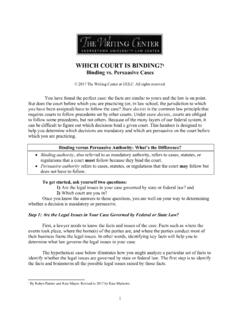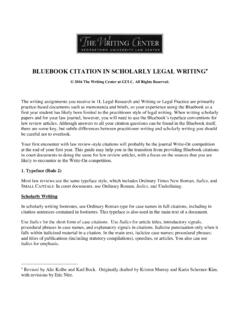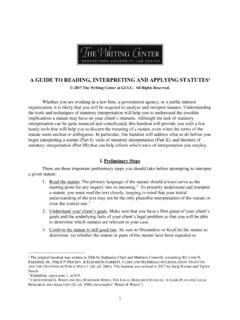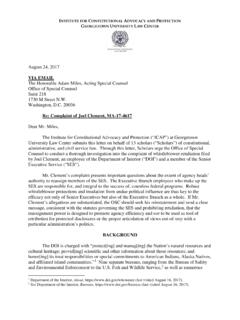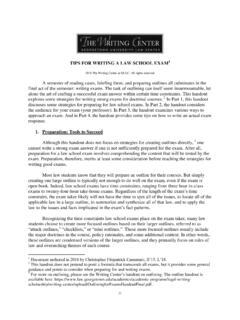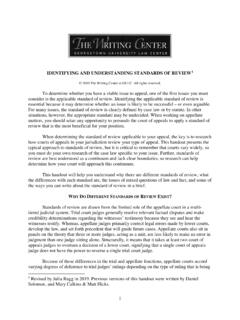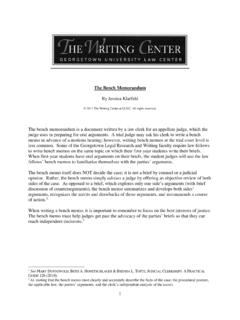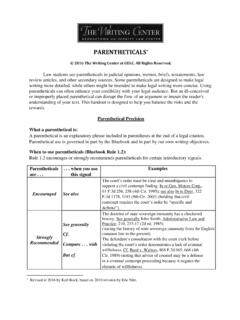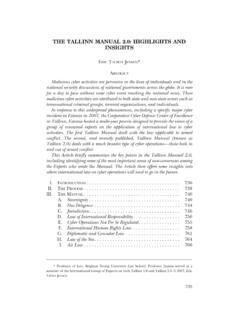Transcription of Federal Law, Federal Courts, and Binding and Persuasive ...
1 1 Federal Law, Federal Courts, and Binding and Persuasive Authority1 2013 The Writing Center at GULC. All rights reserved. The united states is a common law jurisdiction. Common law countries generally give significant weight to prior judicial opinions. By adhering to the outcomes relating to questions of law of prior decisions, common law judges build a body of jurisprudence that, hopefully, leads to consistent and predictable outcomes. In this way, adherence to Binding or Persuasive judicial opinions, serves the same purpose as stare decisis: [The] promot[ion of] the evenhanded, predictable, and consistent development of legal principles.
2 2 Not all prior opinions are created equal, however. Sometimes prior decisions are Binding on courts; courts must follow these Binding precedents. In other instances, prior decisions are only Persuasive ; they provide good rules of thumb, but do not necessarily dictate the Whether a case is Binding or Persuasive can make all of the difference. As such, this handout will first describe the various relationships of Federal courts with other Federal courts and how that affects whether law is Binding or Persuasive . This will teach the legal writer when to recognize whether certain case law is Binding or not.
3 Second, this handout will briefly explain different ways to deal with Binding precedent. This will teach the legal writer how to work around seemingly Binding precedent that undermines the proposition that the legal writer is attempting to establish. Binding Law and Federal Courts The System To understand when an interpretation of law is Binding and when it is not in Federal court , it is necessary to have a basic understanding of the Federal court system. Today, there are ninety- four judicial districts and twelve courts of appeals (the successors to the original circuit courts).
4 4 Moreover, the Federal circuit court of Appeals also hears appeals from trademark and patent cases, but does not oversee its own district Courts of appeals hear cases sitting in panels 1 By Matthew L. Schafer. 2 Payne v. Tennessee, 501 808, 827 (1991). 3 For a detailed discussion of the differences between mandatory and Persuasive authority, see the Writing Center s handout, Can I Cite to Examples and Explanations: How to Use Mandatory and Persuasive Authority. 4 For a discussion of some of the differences between the district courts and courts of appeals, please see the Writing Center s handout, Identifying and Understanding Standards of Review ndouts/identifying-and-understanding-sta ndards-of -review/.
5 5 See Courts of Appeals, united states COURTS, 2 of three judges. Courts of appeals may also sit en banc, meaning that the entire court hears an important question of law. General Rules on Binding and Non- Binding Opinions Generally, district court opinions are not Binding on other district courts or on courts of appeals. The seventh circuit court of Appeals has made it clear, A single district court decision .. has little precedential effect[, and i]t is not Binding on .. other district judges in the same district. 6 Other circuits agree.
6 A court of Appeals Relationship with Its District Courts Courts of appeals are the final arbiters of law in their geographic jurisdictions, absent a determination by the Supreme This means courts of appeals opinions bind district court s in their jurisdictions. Thus, in a habeas corpus case in the united states District court for the Central District of California, a plaintiff argued that the district court should adopt an advantageous rule from the Tenth circuit . This rule was more beneficial to the plaintiff s case and would have allowed him to relitigate a Fourth Amendment issue.
7 The district court , however, declined the invitation: As petitioner s counsel must realize, however, this court sits in the Ninth circuit and is bound by Ninth circuit precedent. 8 The Supreme court s Relationship with Lower Federal Courts Notwithstanding the relationship between courts of appeals and district courts, the Supreme court has the final say in all matters relating to Federal questions of law. As the Supreme court has explained, It is [the Supreme] court s responsibility to say what [the law] means, and once the court has spoken, it is the duty of other courts to respect that understanding of the governing rule of law.
8 9 Distinguishing Binding Precedent Having discussed when a case will be Binding , it is necessary to discuss how a legal writer might go about distinguishing what would otherwise be Binding authority. Indeed, in legal writing, it is important to effectively distinguish prior case law that may run against your client s interests. For a useful map of the current jurisdictions for the Federal courts of appeals see united states courts of appeals, WIKIPEDIA, 6 united states v. Articles of Drug Consisting of 203 Paper Bags, 818 569, 572 (7th Cir.)
9 1987). 7 See, , united states v. AMC Entm t, Inc., 549 760, 771 (9th Cir. 2008) ( Similarly, when the Ninth circuit or any of its coequal circuit courts issue an opinion, the pronouncements become the law of that geographicalarea. ). 8 Nakai v. Pers. Prob. Officer, No. 11-1139, 2012 WL 395896 ( Cal. Feb. 6, 2012). 9 Rivers v. Roadway Exp., Inc., 511 298, 312 (1994). 3 In the simplest sense, distinguishing cases involves showing that the holding of one case need not necessarily dictate the holding of another. 10 There are several ways to show why one case need not dictate the result of the other.
10 First, rules of procedure and similar norms may provide a workaround. Second, the adverse language in an opinion may be non- Binding dicta within an otherwise Binding opinion. Third, and most important, your case and a prior Binding case may be sufficiently factually distinct to prevent the Binding case s application to your case. Procedural Norms Several courts follow procedural norms that may prevent a case from being Binding precedent. In most circuits, for example, unpublished opinions even from a court of appeals itself cannot be cited as Binding precedent.
